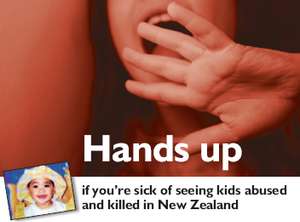Children living with one parent at more risk of abuse: New report
 NZ Herald 29 November 2016
NZ Herald 29 November 2016
Family First Comment: Children living with only one parent or in a blended family are at a higher risk of being abused compared to those living with their biological married parents, a new report reveals.
Children living with only one parent or in a blended family are at a higher risk of being abused compared to those living with their biological married parents, a new report reveals.
A research paper titled Child Abuse and Family Structure, commissioned by Family First, released today highlights a link between children not raised by married biological parents and those suffering abuse.
Bob McCoskrie, national director for family advocacy group Family First, said the research highlighted some key risk factors such as ex-nuptial births where one or both parents were absent, and young mothers and this was over represented by Maori and Pacific cultures. These same groups also had high rates of child abuse.
However, Maori children with two parent working families had low rates of abuse.
In contrast, Asian groups had low rates of child abuse and lowest proportion of single parent families.
Only 9 per cent of Asian families had one parent with at least one child under 18 compared with 28 per cent of Maori.
Whereas only 4.2 per cent of Asian children had been maltreated by the age of 2 compared with 60.9 Maori, 53.2 per cent European, 39.1 per cent non-Maori and 21.7 per cent Pacific.
McCoskrie said the benefits of children being raised by married parents could not be ignored.
However, whenever marriage was promoted, it was seen as an attack on solo or divorced parents, he said.
“In virtually every category that social science has measured, children and adults do better when parents get married and stayed married – provided there is no presence of high conflict or violence.”
The report analysed trends, based on government research, in maltreatment, ethnic groups and family structure dating back from 1967, which is when there was a decline in the marriage rate.
“The research shows it’s the presence of a biological father that generally, not always, protects children and it is marriage that significantly raises the chance that he will remain on the scene,” McCoskrie said.
Co-habited parents were four to five times more likely to separate by the time their child turned 5 than those who were married.
He said the Government needed to stop worrying offending people and instead focusing on the promotion of marriage and preventing marriage breakdowns. More research into married families was also needed in NZ.
“Even to say you want to encourage a marriage culture will get opposition but you have to ask yourself, what is more important. Is it the political correctness or protecting kids?
Report author Lindsay Mitchell, whose earlier research also identified a link between family structures and child poverty, said there were certain family set-ups where children were more vulnerable.
“In the same way discussion about child poverty ignore the elephant in the room – family structure – so do analyses of the incidence of child abuse.”
The report also found a misconception around men predominately being the abusers as the figures showed men were responsible for 60 per cent of physical and sexual abuse, while women were more likely to neglect.
http://www.nzherald.co.nz/nz/news/article.cfm?c_id=1&objectid=11756289







